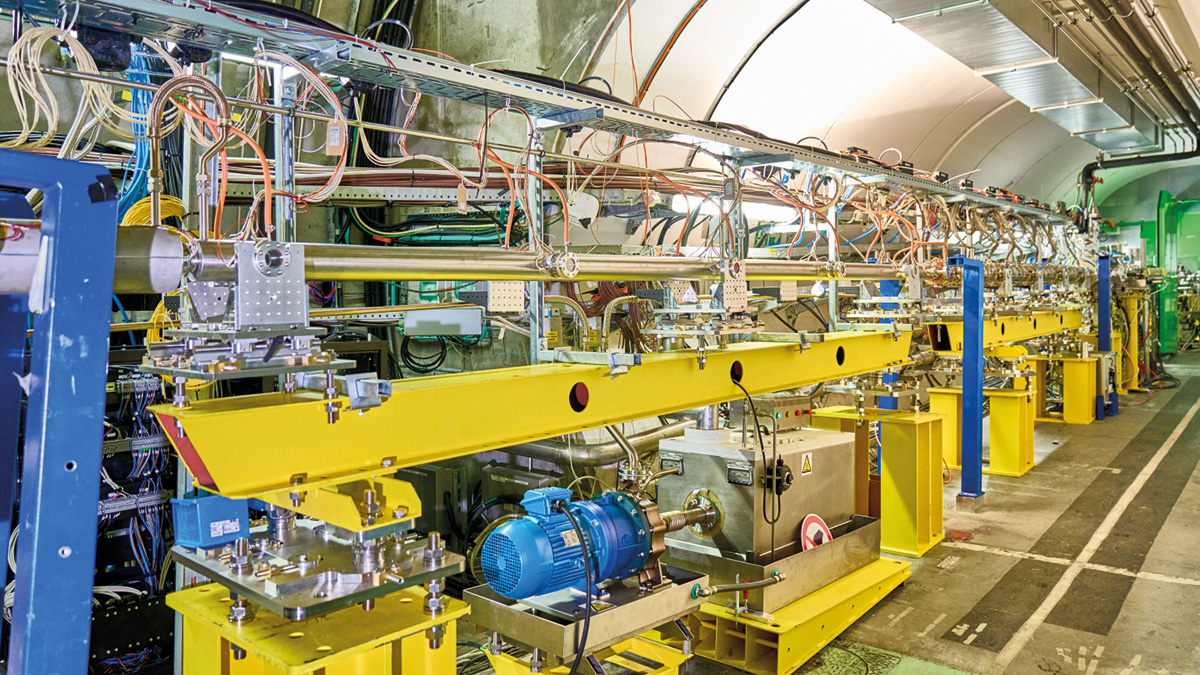This article was originally published in the CERN Courier.
Novel accelerator concepts will play an important role in future accelerators for high-energy physics. Two relevant scenarios being explored in the framework of the European Union I.FAST project are the generation of relativistic single electrons with gigahertz repetition rate for dark-matter searches, and the rapid acceleration of muons with GV/m accelerating fields for experiments at the energy frontier. The topical workshop “Gigahertz Rate and Rapid Muon Acceleration”, held in Bern from 10 to 13 December 2023, addressed the latest developments in these and related topics.
The first part of the workshop was devoted to dark-matter searches and dielectric laser acceleration (DLA). For dark-matter searches, multiple experiments are proposed across different classes (muons vs electrons and positrons, appearance vs disappearance experiments, etc), and an adequate background rejection is important. Promising advanced accelerator technologies are DLA for single electrons – perhaps also muons – and plasma-wakefield accelerators for muons and pions.
Some dark matter-experiments look for an appearance that requires a high flux of incoming particles. For electrons, the standard is set by BDX at JLab, for protons by the proposed SHiP experiment at CERN, and for photons by the proposed Gamma Factory at CERN. In addition, appearances could be seen at existing collider experiments such as the LHC. Other dark-matter experiments search for disappearance. They rely on DC-like electron beams, with prominent examples being LDMX at SLAC and the newly proposed DLA–DMX at PSI. A DC-like muon beam could be explored by the M3 experiment at Fermilab.
Paolo Crivelli (ETH Zürich) described the NA64 experiment as one of the most prominent examples of ongoing accelerator-based dark-matter searches, and presented the first results using a high-energy muon beam. The proposed LDMX experiment at SLAC, presented by Silke Möbius (University of Bern), may set a new standard for indirect dark-matter searches, while advanced concepts employing dielectric laser acceleration, in particular when integrating the accelerating structure with laser oscillator, could achieve many orders of magnitude higher rates of single high-energy electrons entering into an LDMX-type detector.
Uwe Niedermayer (TU Darmstadt), Stefanie Kraus (University Erlangen-Nürnberg) and Raziyeh Dadashi (PSI/EPFL) reviewed the state of the art in DLA plus future plans. Yves Bellouard (EPFL) discussed advances in high-repetition-rate lasers and micro/nano-structures, which suggests that the proposed combined laser-accelerator structures are within reach. Of course, the detector time resolution would also need to be improved tremendously to keep pace with the higher rate of the accelerator.
Acceleration and decay
The second part of the workshop was devoted to the plasma acceleration of non-ultra relativistic and rapidly decaying particles, such as muons and pions. Vladimir Shiltsev (Fermilab) and Daniel Schulte (CERN) presented tentative parameters and ongoing R&D efforts towards a muon collider. Shiltsev also discussed the intriguing possibility of low-emittance muon sources based on plasma-wakefield accelerators, while Alexander Pukhov (Heinrich Heine University Düsseldorf) and Chiara Badiali (IST Lisbon) discussed how plasma acceleration could bring slow particles, such as muons, to relativistic velocities.
The workshop fostered numerous heated discussions and uncovered unresolved issues, which included the “Bern controversy” regarding the ultimate limits of luminosity for PeV energies. Muons are considered particles of choice for future accelerators at the energy frontier. Both low- and high-energy muons have useful applications. Is there an Angstrom limit to the beam diameter? Are tiny beta functions possible? Can plasmas help to overcome such limitations? Understanding and modelling non-point-like particle luminosity is another important topic, also relevant for the Gamma Factory.
The workshop showed how advanced accelerator concepts can jump-start dark-sector searches
The final part of the workshop assembled a roadmap and perspective. DLA studies are to be maintained and, if possible, accelerated. A reasonable target is achieving a gradient of 500 MeV/m and an energy gain of 0.05 GeV in five years on a single wafer, while an integrated DLA laser oscillator could be foreseen five to seven years from now. Plasma-wakefield acceleration of muons could conceivably be tested either at CERN–AWAKE or PSI. It was proposed, as a first step, to put a solid target or tape into the AWAKE set up.
The gamma factory, presented by Witek Krasny (LPNHE), was recognised as an intense source of polarised muons and positrons. For muon-acceleration studies, the dephasing issue, linked to the muons’ non-ultrarelativistic energy, seems to be resolved. A demonstrator experiment for muon plasma acceleration is called for. Open questions include when and where?
Overall, the Bern workshop showed how advanced accelerator concepts can jump start dark-sector searches and muon/pion acceleration. High-repetition-rate acceleration of single electrons for dark-matter searches, using dielectric laser accelerators, and applying high-gradient plasma acceleration to muon and/or pion beams, are intriguing and far-forward looking topics.

